Artists & Performers
Meet our celebrated artistis and performers hailing from various styles of music and dance in the Indian classical music community who add magic to our events and grace us with their outstanding talent across all types of classical instruments
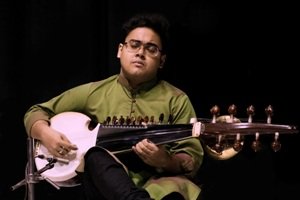



Abhijit Banerjee
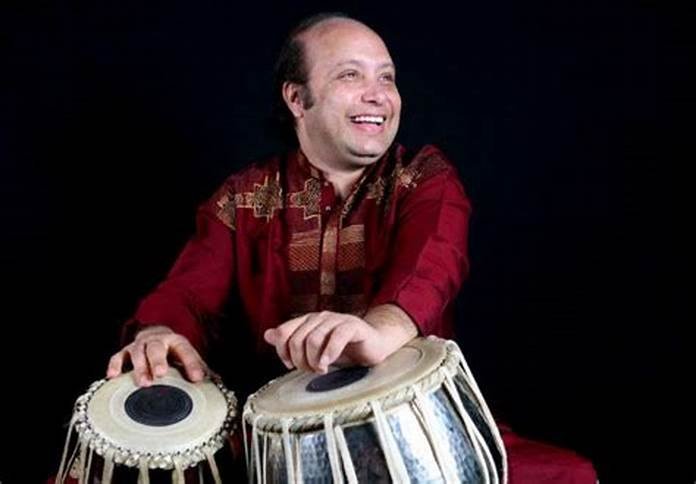
Abhijit Banerjee
Abhijit started learning tabla at a very tender age from Sri Tushar Kanti Bose , later from Sri Manik Pal and finally came under the tutelage of Pandit Gyan Prakash Ghosh. As a child he won many Music competitions of national repute. Besides tabla, he had his training in vocal music and in violin.
Abhijit is now a regular performer at all the major music conferences all over India and overseas.
Besides accompanying all the major artistes of India, both in North Indian and South Indian tradition, Abhijit has the privilege of presenting himself as a solo performer in many music conferences in India and Abroad. He has toured extensively all over the world and also associated himself with Jazz world and performed with some Jazz musicians and groups in New York. Abhijit has conducted many seminars on Indian Classical Music, at Universities in U.S.A. , Japan , England and Spain.
Abhijit has recorded many CDs with many reputed companies accompanying almost all the major artists in Indian Classical Music today ; as well as many well-known Jazz musicians. He has also recorded a Tabla solo CD, which is now available from Magnasound and Peshkar CD.
Abhijit has composed music for TV serials and short films of which THE TRAILS- a film on Calcutta- got the National Award and is invited in the film festivals in Amsterdam and Munich.
Abhijit has the privilege of representing India in the World Festival of Music held in Granada , Spain.
In his academic life he is a graduate in English and post graduate in Journalism.
Anand Gopal Bandopadhyay
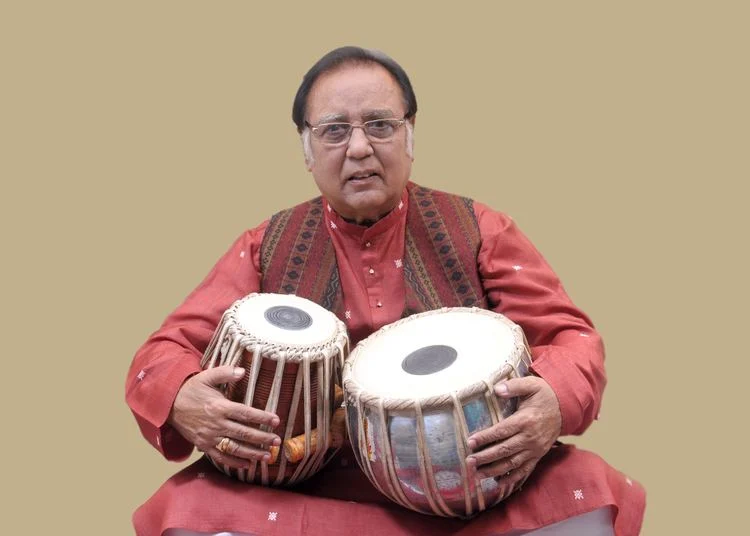
Anand Gopal Bandopadhyay
Indian Classical Music is an on the spot creation within the framework of the raag. Providing accompaniment for a pre-composed item is totally different from that of a spontaneous composition. Here the mood of the artiste reigns supreme. The accompanist has to understand the psyche of the artiste as well as the requirement of the moment and accordingly give either subdued support, one to one dialogue, or absolutely thrilling display of his talent.
Anand Gopal Bandopadhyay and his tabla have all these characteristics in abundance. An ardent admirer of the art of sangat, he had his initial training from his father Pandit Mahadeo Prasad Misra (Benaras gharana) who formally trained him into an accomplished tablist. At the tender age of 18 he won the first prize in tabla in the All India Radio Music Competition. At present, he is the top grade artist of A.I.R.
This was just the beginning of a brilliant career of this sensitive tabla player who is successful both as a soloist as well as an accompanist. His popularity took him to places including World Youth Festival (Berlin), Festival of India (Maryland), Boston, New York, San Francisco to name a few. Apart from these performances, he was associated with many prestigious organizations like Song and Drama Division, Delhi, Faculty Music and Fine Arts, University of Delhi, Amir Khusrau Society of Chicago. At present he is a full time member of the faculty of Sangeet Research Academy, Calcutta.
… Maestros mesmerize with celestial music…. Anand Gopal Bandopadhyay enthralled the audience with his Benarasi style of percussion. The Hitvadi
Anand Gopal Bandopadhyay who belongs to Bishnupur gharana is a tabla player par excellence …. And has regaled the audience each time ….. .His accompaniment of the singer enhances the beauty and the serenity of the program. Nagpur Times
… In the layakari Nag (main artiste) maintained a high standard and wide rhythmic range. Anand Gopal Bandopadhyay on the tabla maintained the right pace and rhythm throughout. The Telegraph
Anand Gopal Bandopadhyay on the tabla followed him (Rashid) with competence. Sunday Financial Express
The program was a total success from beginning to end. Anand Gopal accompanied…. On the tabla. He maintained the desired musical temperament throughout the program. The Telegraph
Anand Gopal Bandopadhyay was the hardest working accompanist of the festival. Evening after evening he accomplished the task with great ability. Accompaniment with vocal and instrumental music needs different kinds of skill and Anand Gopal has both in an ample measure, enabling him to add luster to the main item, whether it is vocal or instrumental. The Hindustan Times
Aneesh Pradhan

Aneesh Pradhan
Arati Ankalikar Tikekar

Arati Ankalikar Tikekar
Arawind Thatte

Arawind Thatte
Arawind Thatte, born in a musical family of intellectuals has been playing harmonium since his childhood. He also played Tabla under the guidance of late Pt. G.L. Samant. He was trained in vocal music at Bharat Gayan Samaj (Pune). Today, Arawind has become a renowned Harmonium player and has accompanied almost all stalwarts of classical music. In addition he has participated in more than 125 programs of Marathi light music “Mantarlelya Chitrabanat”. He has traveled extensively around the world and has performed all over India, on Radio and TV and in most prestigious music conferences. Besides music Arawind has a brilliant academic career with a doctorate in Mathematics.
Atul Desai

Atul Desai
Bhajan Sopori
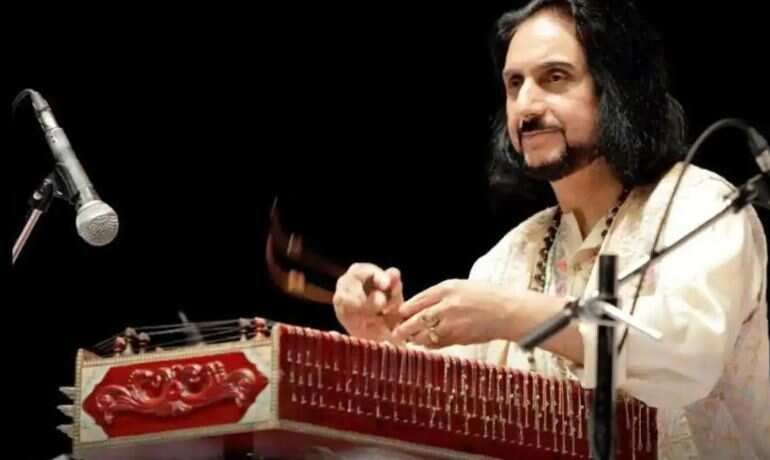
Bhajan Sopori
Budhaditya Mukherjee
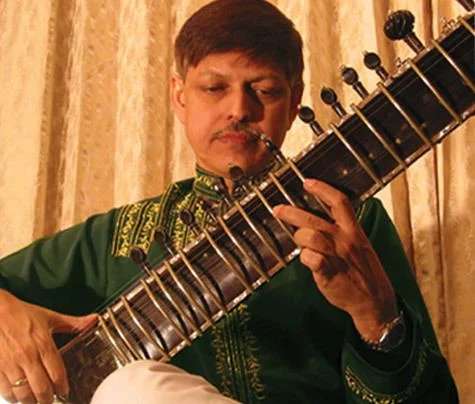
Budhaditya Mukherjee
Firoz Dastur
Firoz Dastur
John Wubbenhorst

John Wubbenhorst
Master Flutist, John Wubbenhorst, has a unique distinciton of being a fluent virtuoso on both western flute and bansuri (bamboo flute). His rich and varied background includes extensive training in jazz, western classical flute, and music of world cultures. Since 1986 John has embarked on an in-depth study of the classical Indian raga forms with some of India’s great master musicians, culminating in years of intensive studies with Pundit Hariprasad Chaurasia, master of the Indian bansuri.
John has recently formed Facing East Productions which has produced his first CD entitled “Facing East”. The CD features original compositions by John, which integrate raga forms with western compositional techniques. The diverse instrumentation includes flute, bansuri, tabla, guitar, synthesizer, sarod, violin, bass, and various percussion. Already,it has received much critical acclaim .
Having traveled and performed throughout the world John has developed a style that has universal appeal. His eclectic influences have made him a featured performer and composer in a variety of contexts. He has performed with such musicians as Pundit Hariprasad Chaurasia, Pundit Debu Chaudhuri, and Paul Horn; and he has made appearances on several recordings including ones by Sanjay Mishra/Jerry Garcia, Broto Roy and Pundit Hariprasad Chaurasia.
As a composer, John has composed and performed music for various dance and theater groups at Arena Stage, the Kennedy Center, the Smithsonian, Library of Congress, and the national Institute of Health. He also teaches an East/West Improvisation workshop for universities, conferences, and clinics around the country.
Born in Rowayton, Connecticut, John’s early education included studies with Kim Haley from Julliard School of Music (western classical flute), Darius Brubeck (jazz, composition, ethnic musicology), and Berklee College of Music (jazz). Later he attended Maharishi International University receiving a B.A. in Education, and graduate studies at Rotterdam Conservatory in Holland.
Jyoti Goho
Jyoti Goho
Kala Ramnath
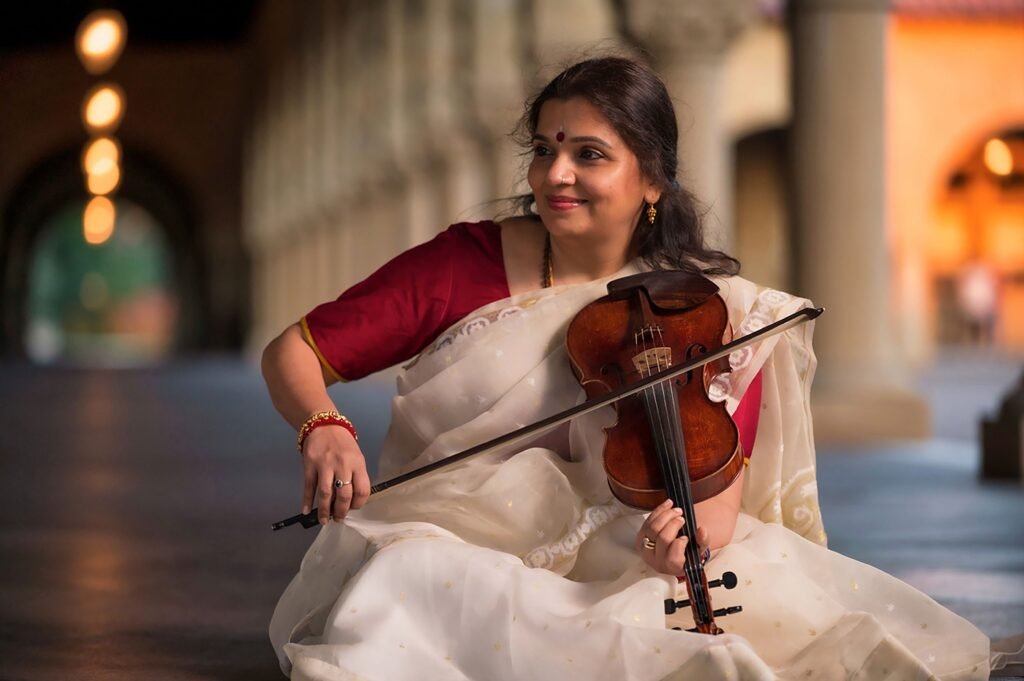
Kala Ramnath
Emerging rapidly as one of the most outstanding violinists in the Hindustani Classical genre in India today, young Kala Ramnath, from the Mewati gharana has adapted this western instrument to express the deep and intense spiritual lyricism and power of the classical Indian tradition. Hailing from a family to which the music world owes two of its front-ranking violinists, Prof. T.N. Krishnan in Carnatic and Dr. Smt. N. Rajam in Hindustani music, Kala began playing the violin from the age of three. She started her training with her grandfather, Vidwan Shri Narayan Iyer and simultaneously, from her aunt, Dr. Smt. N. Rajam. For the last seven years, she has been undergoing intensive
training with Pandit Jasraj, master vocalist of the Mewati gharana.. This has brought a rare vocal emotionalism to her art.
Kala’s violin playing is characterized by an immaculate bowing and fingering technique, command over all aspects of laya, richness and clarity in sur. All this innate artistry and technical brilliance combined with a rare and exquisite emotional quality are the hallmarks of her style.
Kala has performed at many major music festivals like Tansen Sangit Sammelan, Swami Haridas Sangit Sammelan, Pandit Motiram Sangit Samaroh, Sangit Natak Academy’s Music and Dance festival, Ustad Amir Khan Samaroh, Spirit of Unity Concerts, Harvallabh Sangit Sammelan, Vishnu Digambar Jayanthi etc. In the year 1984, she won the first prize in the prestigious All India Radio Music competition. In 1988, she became the first ever Hindustani musician and violinist to record for CBS India Limited.
Beisdes being a brilliant and charismatic musician, Kala has also an outstanding academic record. A University 1st in her Graduation and Post-Graduation, she won the junior and senior Government scholarships in the years 1979 and 1984 respectively. She is also an A-grade broadcaster and telecaster.
Kala has won the acclaim of critics and discerning audiences nationwide. She recently performed in the world music festival at Montreal, and the Canada Council’s festival ‘Rhythms of India’ in Ottawa, both in Canada. She has also extensively toured in the U.S., Canada, Europe and Mauritius. Her 1995 tour in the United States and Canada has been specially fruitful for Kala, as she blazed a whirlwind trail across the continent, gaining accolades and ovations wherever she went. Soloing in June last year in Los Angeles, for Pandit Ravi Shankar’s 75th birthday celebration, Kala left an unforgettable imprint on the minds of her listeners.
Kartik Seshadri
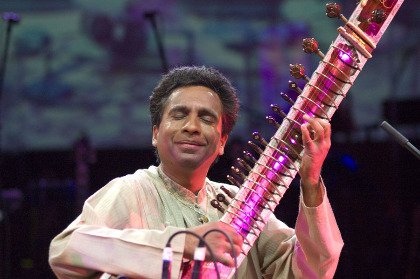
Kartik Seshadri
Sitar virtuoso Kartik Seshadri is internationally acclaimed as one of India’s outstanding musicians and the foremost disciple of Pandit Ravi Shankar. Kartik was hailed as a child prodigy by critics and prominent musicians when he began performing full-length solo recitals at the age of six. His initial training in music began with Shri Shankar Rao of All India Radio, who nurtured his precocious musical abilities. As a young genius, Kartik had an illustrious performing career, and in 1965 he met the world renowned maestro Pandit Ravi Shankar, who was already a profound musical influence in his life. Kartik became a disciple of the maestro in 1974 and has since been receiving taleem (knowledge) steeped in the distinctive and pure styles of the senia, beenkar and dhrupad traditions.
As a soloist, Kartik performs extensively in major venues throughout India and abroad. His concerts in India frequently include prestigious festivals such as the Sangeeth Nataka Academy, Madras Music Academy, Indian Fine Arts Society, Saptak and Sancharini, establishing him as a musician of national importance. In the United States and Canada, Kartik’s recent solo engagements have included the Lincoln Center, Kennedy Center, World Music Institute, Asia Society, Vancouver Jazz Festival and Ravi Shankar’s 75th Birthday Celebrations. Kartik has had the added honor of accompanying Pandit Ravi Shankar in major concert halls throughout the world: India, Europe, Middle East, Japan, Mexico and the United States, including Carnegie Hall. His consistently brilliant performances are marked for their expressivity, rich tonal sensibility and exciting rhythmic intricacy.
Kaushiki Chakraborty
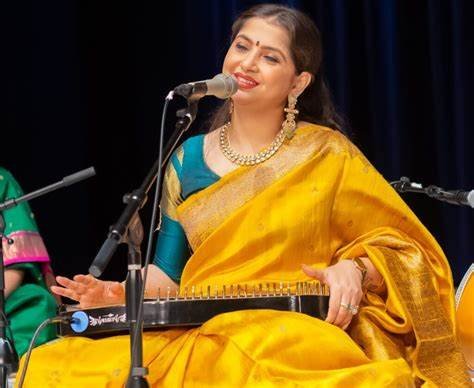
Kaushiki Chakraborty
Daughter of renowned vocalist Pandit Ajoy Chakraborty, Kaushiki has music in her blood. She breathes music twenty-four hours a day as she was born and brought up within the four walls of Sangeet Research Academy. Born in 1980, she could reproduce all musical and rhythmic phrases with ease by the time she became two years old. She learnt to play with the magical seven notes under her mother’s guidance.
Kaushiki’s formal classical training started at the age of seven when she became a student of Padmabhushan Deshikottam Guru Jnan Prakash Ghosh. At present she is learning from her father Pandit Ajoy Chakraborty at SRA as a scholar after going through the stringent eligibility tests of SRA in flying colors.
Kaushiki has participated in many concerts and conferences in India and abroad. She was well received in the USA, Canada in 1987 where she performed along with her father. On the 18th May 1997 she participated in the Spring Festival of Music, Pasadena (California), USA.
Her brilliant performances fetched her many awards and raving reviews. Salt Lake Cultural Association of Calcutta presented her coveted Jadu Bhatta Award in 1995. Pandit Bhimsen Joshi the living legend of Kirana-Indore gharana believes that Kaushiki is certainly going to make a mark as a classical vocalist in the 21st century.
Mallika Sarabhai
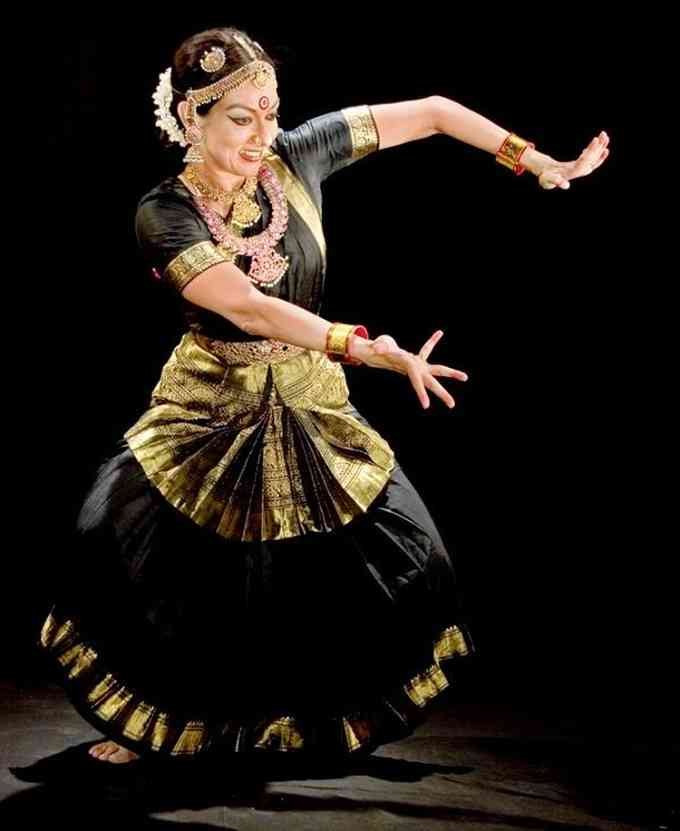
Mallika Sarabhai
In V for …
Direction: John Martin
Choreography: Mrinalini and Mallika Sarabhai
Violence is everywhere, yet violence is taboo. It must be dealt with, but we are afraid of its power. Across the ages, across all cultures, artists have found one form, one persona, who can wake up, who can speak the unspeakable, and point the finger to where we dare not look. The Vidushaka of Sanskrit Drama, the Fool of Shakespeare, the Rangalo of Bhavai, the Clown and the Satirical Cabaret compere, have all played this role with a freedom found from behind their masks. In V for … Mallika Sarabhai’s new incarnation of this Vidushaka is modern, daring, and slips in and out of the characters who represent the darker side of our society, and of ourselves.
Layering on-stage action with video screen material of the violators’ thoughts and actions, and with taped voices of the great non-violent peacemakers like Gandhi, Martin Luther King and the thoughts of Gautam Buddha, gives the audience a depth of theatrical experience.
John Martin and Mallika Sarabhai have been working together for several years on creating performances which use a wide range of theatrical skills to provide fresh and challenging looks at social and cultural issues. Shakti – The Power of Woman, and Sita’s Daughters both examined images of Indian womanhood debunking the male clichés and celebrating strong positive examples of women who refused to be downtrodden. Itan Kahani – The Story of Stories celebrated the rich diversity of story-telling techniques from around the world while, at the same time, uncovering the repressive cultural messages encoded in so many stories. These, and their other collaborative creations, have been seen widely in India, West Africa, Europe and the U.S. During all this time, one issue has been burning in them, the frightening growth of violence within our supposedly civilized, advanced and sophisticated world.
Pandit Hariprasad Chaurasia

Pandit Hariprasad Chaurasia
Pandit Hariprasad Chaurasia not only occupies a unique place in India as the country’s top ranking flutist, but he is acclaimed world-over for his mastery of the melodious wind instrument, Bansuri the bamboo flute.
Born in Allahabad in 1938, the son of a wrestler, he was initially destined to follow his father’s career, and despite having always been attracted to music (mostly in the form of film tunes and radio broadcasts), he did not receive any formal musical training until the age of 15, when he began to learn classical singing with Pandit Raja Ram, a local vocalist. Within a year he decided to switch to the bamboo flute after hearing a recital given by Pandit Bholanath, a renowned flutist from Benares, whose pupil he became. But he owes much of his success to Smt. Annapurna Devi, the brilliant daughter of the greatest musician India has produced in this century, the late Acharya Allauddin Khan of Maihar. Not being a flute player herself, she taught by singing to him most appropriately in view both the musical traditions of India and the individual qualities of his chosen instrument.
In the dexterous hands of Pandit Chaurasia, the bamboo flute emerges from its pastoral background to express nuances of Indian classical music with unsurpassed elegance. His rendering of classical as well as light classical compositions is unusually imaginative and is characterized by a complete command over layakari, i.e. the rhythmic structure of music.
As a musician Pandit Chaurasia is a rare combination of innovator and a traditionalist. He has significantly expanded the expressive possibilities of the bamboo flute with his masterful technique. Pandit Chaurasia has performed internationally and has participated in numerous music festivals organized in nearly every country of the continents of Europe, North America, Australia and Asia.
In 1984, in recognition of his outstanding contributions in Indian classical music, the Sangeet Natak Academy (i.e. the Indian Academy of Music, Dance and Drama), presented him its National Award. He is recipient of two of the most prestigious awards in performing arts; the Maharashtra Puraskar, given by the state of Maharashtra and the Konrak Samman given by the state of Orissa. In 1992, the president of India bestowed him the title of Padmabhushan, one of the highest civilian awards that can be given to an Indian national.
Pandit Vishwa Mohan Bhatt
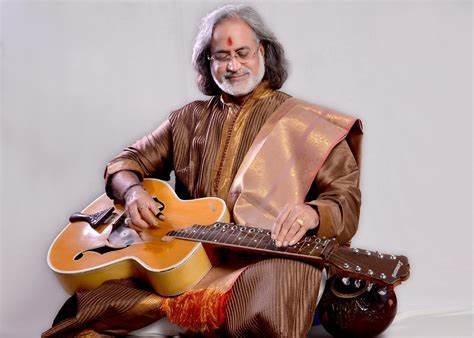
Pandit Vishwa Mohan Bhatt
Creator of the Mohan Veena and winner of a Grammy Award in 1994 with Ry Cooder for their world music album, A Meeting by the River, Vishwa Mohan has mesmerised the world with his prestine pure, delicate yet fiery music. His faultless legato, his natural ability to play the Tantrakari Ang and incorporate the Gayaki Ang on the Mohan Veena have made him one of the most expressive and versatile slide guitar players of our time.
Being a disciple of Pandit Ravi Shankar , Vishwa Mohan belongs to that elite body of musicians which can trace its origins to Tansen and his guru, the Hindu mystic Swami Haridas.
Vishwa Mohan has collaborated with musicians all over the world including Chinese erhu player Jei Bing Chen, American dobro player Jerry Douglas, American country music singer Taj Mahal and Arabian oudh player Simon Shaheen.
Prabhakar Karekar
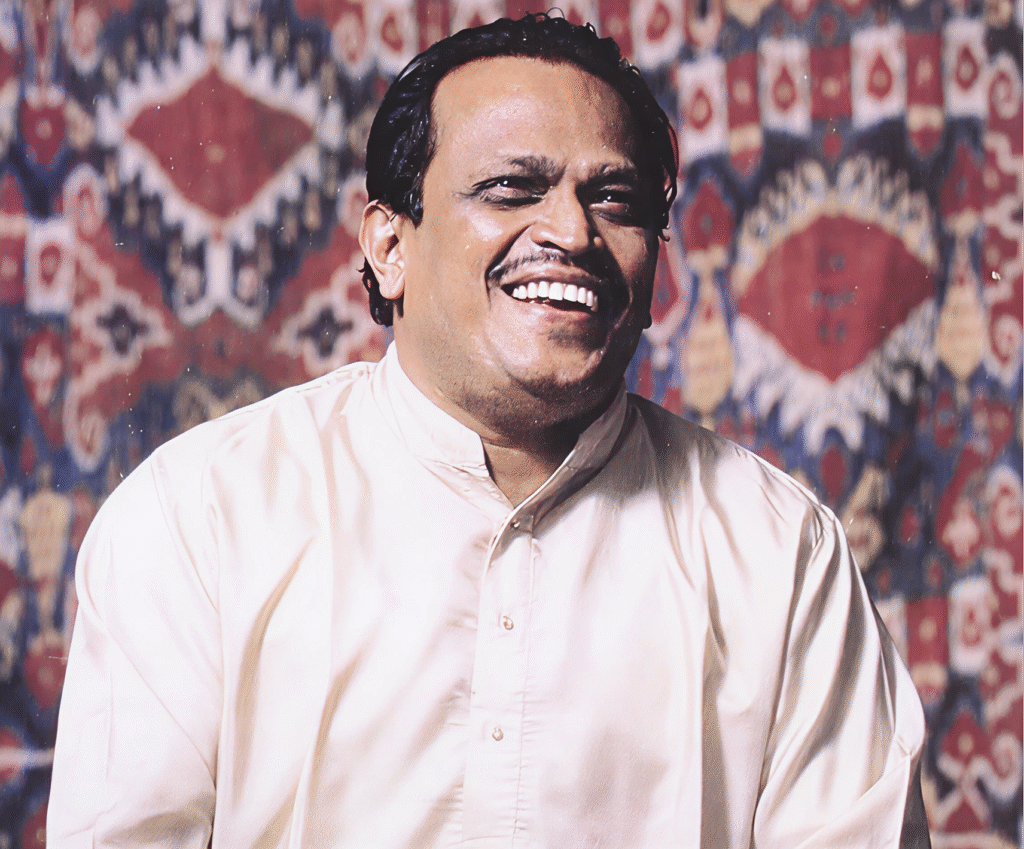
Prabhakar Karekar
A vocalist trained in the Northern Indian style, Prabhkar Karekar has earned a name for himself through out India as well as abroad, having toured extensively in the U.S., the U.K., and the Gulf Countries.
From the Province of Goa, Prabhakar left home at the age of 14 and began his initiation in the fundamentals of classical music with “Pandit Suresh Haldankar. He followed that with a discipleship with noted maestro ëPandit Jitendra Abhiseki. At the present he is under the tutelage of the famous exponent of the Gwalior and Agra gharanas Pandit C.R. Vyas. Karekar has taken the essences of the various schools and formed a style of his own that has enamored him to his listeners. His rendering of the Khayal as well as his emotional singing of Thumri, Dadras, Bhajans, and Natyageets, has gained him fame through out India. Karekar has to his credit many records, audio tapes, and a CD recently produced in the U.S.
Professor T. N. Krishnan
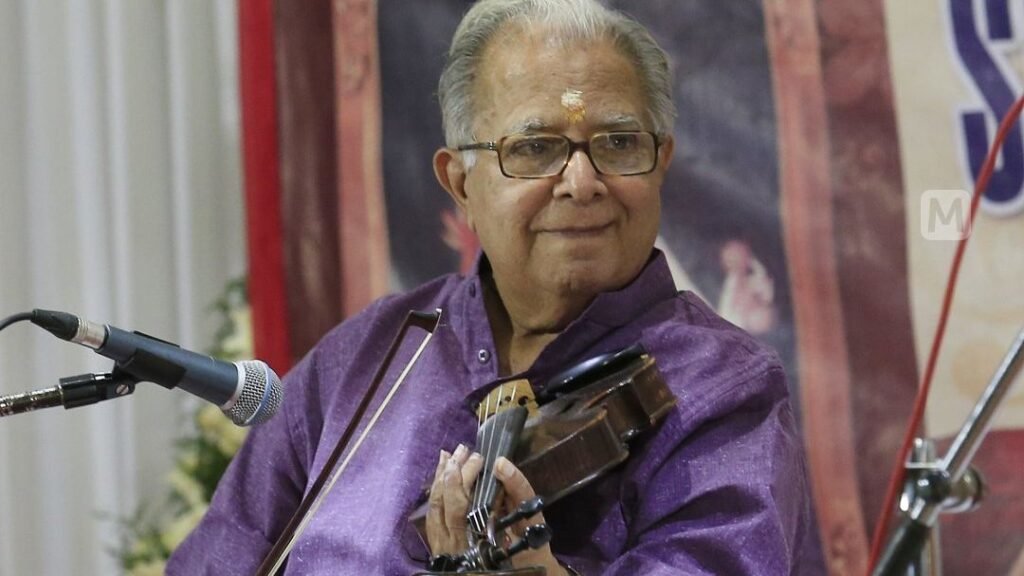
Professor T. N. Krishnan
Sangeetha Kalanidhi Professor T. N. Krishnan, recognized as one of the world’s finest violinists, had his training under his father A. Narayana Iyer and Sri Semmangudi Sreenivasa Iyer, the doyen of Carnatic music. A winner of many coveted awards – Sangeetha Kalanidhi from Music Academy, Madras, The Sangeet Natak Academy award from the Government of India, Padma Bibhushan from the President of India, to name a few. Professor Krishnan has served in many important positions: Professor, Government Music College, Madras, Principal, Tamilnadu Government Music College, Head of Carnatic Music section of the Delhi University, Vice Chairman of the Sangeet Natak Academy, Government of India, Visiting Professor, the Center for World Music, Berkley, California. Professor Krishnan has toured the U.S., U.K., Canada, Australia and other countries many times presenting and delighting the audience.
To quote a couple of reviews by leading magazines around the world:
There is a vibrant, emotional warmth, technical precision and perfection in his delightful melodic rendition. The serenity and total virtuosity are soothing and endearing. Evocative improvisation and nuances, (and) tantalizing subtlety with clarity providing absorbing interest in the listener mark his concerts. His impeccably smooth bowing blends severe classicism with depth, and fluency with polish.
In his hands the instrument exudes a sweet tonal quality which imparts an indefinable charm to his playing.
Rajeev Taranath
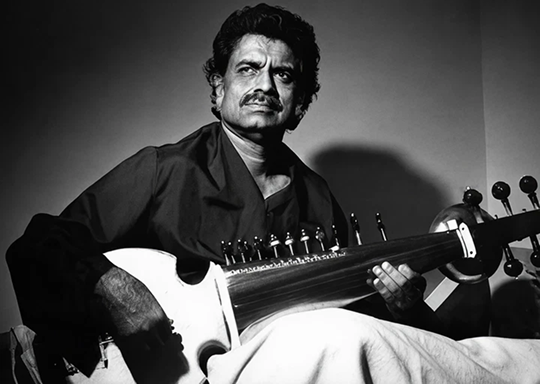
Rajeev Taranath
Internationally acclaimed performer and award-winning composer, Rajeev Taranath is today one of the world’s leading exponents of the sarod, the richly textured Indian classical instrument which is an ancestor of the late. Pt. Taranath’s performances masterfully combine the depth and rigor of the tradition of Hindustani (North Indian) classical music with an inspired imagination and emotional intensity. He is a distinguished disciple of Maestro Ali Akbar Khan.
Rajeev was hailed a prodigy in Hindustani vocal music as a young boy. He had been trained by his father Pandit Taranath and other eminent musicians and was a concert and radio artist before he was twenty.
Rajeev has toured extensively as a performer in India, Australia, Europe, Yemen and throughout the U.S. In 1998 he received the prestigious national ‘Chowdiah’ Award from the government of Karnataka in India for excellence in the field of instrumental music. In 1980 he was the subject of a documentary made for the television in Eden, Yemen, entitled “Finnan Min-Al- Hind” (“Artist from India”). He has received three additional awards from the Indian government for his contribution to music,- the ‘Sangeet Nritya Akademi Award’ in 1993, the ‘Karnataka Rajya Prashasti’ in 1996 and recently the ‘Sangeet Natak Academy award in 2000. He has also composed music for several nationally and internationally honored Indian films.
Rajeev Taranath’s distinctive musicianship demonstrates striking imaginative power, technical excellence and emotional range. He is respected for the clarity of musical understanding which he brings to the unfolding of a raga and the beauty of tone he evokes from the sarod. The New York Times (April 14, 1982) described his music by commenting with great enthusiasm about the exuberance and versatility of his playing, which ranged from the “spiritual to the spirited”.
Rajeev was a Ford Foundation scholar (1989 to 1992) and researched during this period on the “Teaching Techniques of the Maihar-Allauddinn Gharana”.
Rajeev has also received guidance from Pandit Ravi Shankar and Shrimati Annapurna Devi.
He is currently a faculty member in the Indian music department at the California Institute of the Arts in Los Angeles, California and divides his time between teaching and performing.
Ramesh Mishra
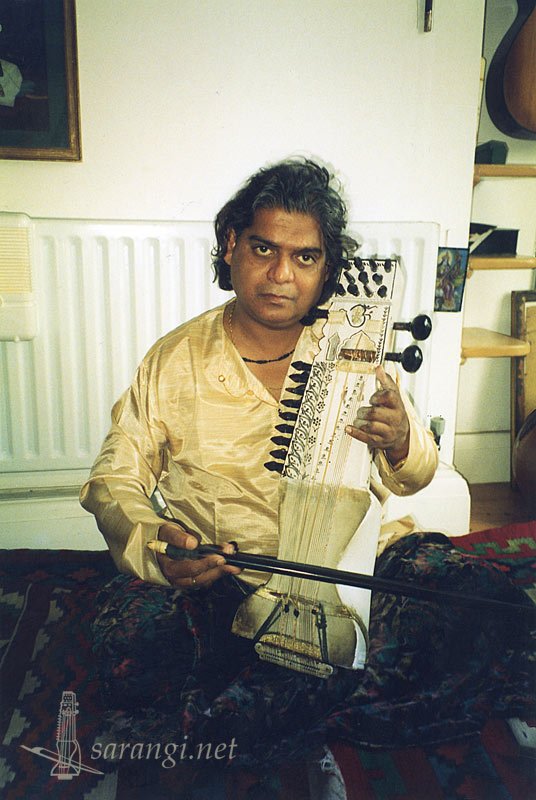
Ramesh Mishra
Born in 1952, Ramesh Mishra is one of the outstanding exponents of Sarangi from the Benaras Gharana and represents the twenty third generation of Sarangi players in his family. Sarangi, which literally means ‘a hundred colors’, is a unique stringed instrument and is one of the most difficult instruments to master, despite its popularity as an accompanying instrument. Ramesh Mishra’s ability to exploit the potentials of this instrument is incomparable.
Initiated by the great Sarangi maestro Late Pandit Gopal Mishra and later groomed by his father Late Pandit Ramnath Mishra, Ramesh has come under the tutelage of the legendary Sitar maestro Pandit Ravi Shankar for the last several years. The association brought both the maestro and the disciple together in performances, recordings and projects all over the world.
As an All India Radio and Doordarshan artist, he has accompanied almost all the leading musicians of India and performed in numerous conferences and festivals all over the globe, both as a soloist and as an accompanist. He has been honored by the Sangeet Natak Academy Award for his sincere service to music.
Rashid Khan
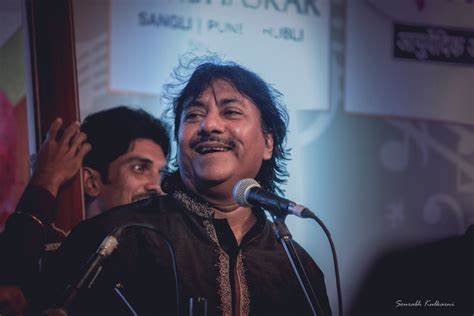
Rashid Khan
Rashid Hussain Khan, born in 1966, is perhaps the most convincing proof of what miracles the revived “Gurukul” system can achieve. Under the tutelage of Ustad Nisar Hussain Khan, the Sahaswan Gharana maestro, Rashid has metamorphised into an artist of unbelieveable maturity, vocal prowess and artistry. Rashid Khan has been affiliated with the Sangeet Research Academy in Calcutta, the premier foundation of North Indian Classical Music for several years. Rashid’s alaap is highly imaginative, his rythmic play pulsating and the cascades of his powerful, lightning swift taans is unimaginable until heard. His internalistion of raag-bhaav is uncanny. Rashid has naturally taken listeners and the Press by storm wherever he has gone. At a 1982 conference in Bhubaneshwar, a member of audience was so overwhelmed by the uncanny expertise of the young boy that he promptly made him a gift of One Thousand Rupees. In 1986 the Festival of India authorities invited Rashid Khan to present the only music on the occasion of the release of the Double Album on Great Masters of Indian Music by the then Prime Minister of India, late Rajiv Gandhi. The concert was intented to signify the continuance of the tradition of excellence in Indian Classical Music. Rashid Khan was awarded the ‘A’ Grade by All India Radio in 1987. In 1988 he cut his first record, and has several discs and cassettes to his name subsequent to the occasion. He has performed extensively throughout the world, taking as usual, crowds by storm. Rashid Khan has been hailed as a great successor to the generation of Ustad Bade Ghulam Alil Khan and Amir Khan – an era today almost given up as lost. Rashid visited the DFW metroplex once in 1989 and set a lasting impression on the audience of his concert here. This will be his second visit to the metroplex (1998).
Samar Saha

Samar Saha
Rhythm represents life. Music also becomes lively and enjoyable with the help of the rhythm. The slow and fast tempo in soft or bold tones brings tremendous variety to an otherwise monotonous musical event. A matured musician therefore needs a matured percussionist without whom his recital does not bloom. One such percussionist is Samar Saha. Numerous musical performances by renowned artists started throbbing with life with the magical touch of his fingers on the tabla. He belongs to the Benaras gharana. Born in Calcutta, Samar’s initial training started at very tender age under the guidance of his father Shri Sudhanga Bhusan Saha and brother Shri Tarak Saha – a tabla player of repute. His formal training started under the tutelage of Shri Satchidananda Goswami and then flowered under the able guidance of Shri Krishna Kumar Ganguly (Natubabu) of Benaras gharana. At a very young age Samar showed to be a performer of great promise. Frequently featured on Radio and TV in their musicals, Samar has participated in almost all the prestigious music conferences in India. His talent took him to the Festival of India, USA. Fame and recognition came his way wherever he performed; be it Bangladesh or Belgium; America, Canada, UK or Germany. A sought-after tabla accompanist, Samar is successful in both live and recorded performances. As a result he has numerous cassettes albums and compact discs of classical music to his credit. Samar Saha is a full time faculty member of Sangeet Research Academy since its very inception in 1978. According to Prakash Wadhera, a well-known music critic, “ITC is extremely fortunate in having the services of ace tabla player Samar Saha. Effortless and unobtrusive, Samar seems to have attained the very perfection in the art of rhythmic accompaniment..”
Sandip Burman
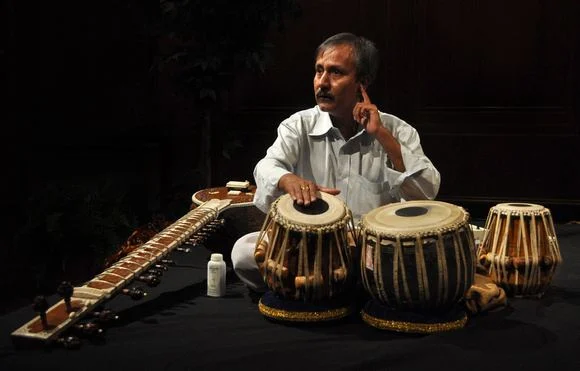
Sandip Burman
Born in Durgapur, near Calcutta, Sandip Burman began his training on tabla at age six. After his initial training with Sudhir Roy, he began his long discipleship with the distinguished Prof. Shymal Bose of Calcutta. Sandip has received numerous degrees recognizing his musical accomplishment, Sangeet Prabhakar from Allhabad, Sangeet Visharad from Chandigarh, and Sangeet Probor from West Bengal. Today he has established himself as one of the most talented young tabla players in Indian Classical Music. Sandip Burman’s emerging talent has captured the hearts and minds of music lovers wherever he has performed. He has earned considerable popularity through his wonderful performances both at home and abroad. Already recognized for his creativity, Sandip has accompanied artists, including Pandit Ravi Shankar, Chitresh Das, Buddhadev Dasgupta, Ali Ahmed Hussein, Pandit Jasraj, Tanima Thakur, Bhajan Sopari, K. Shridar, Subrata Roychoudhury, Biswajeet Roychoudhury, Rajeev Taranath, Indranil Bhattacharya and others. Sandip has performed as accompanist and soloist at a variety of venues in the U.S., including Ali Akbar College Festival, Channdham School of Dance, CalArts, Standford University, Arizona State University, San Francisco State University, U.C.S.D., and York College (PA). Sandip is a regular artist of All India Radio and Television. Sandip has also appeared on Swedish Radio, Zambian Television and the Festival of Music Tour of North Africa.
Shubha Mudgal

Shubha Mudgal
Shubha Mudgal’s musical accomplishments are truly remarkable and today she is considered by many as one of the most imaginative and versatile female vocalists of India. Like most young vocalists, Shubha has received training from many. Born in Allahabad to a family with rich musical tradition, she began her training under Ram Ashray Jha, a highly respected composer and a vidwan. She then received extensive guidance from both Vinay Chandra Maudgalya and Vasan Thakar. She was fortunate to come under the influence of Pandit Kumar Gandharva and Pandit Jitendra Abhisheki, who gave her understanding of stylistic techniques. Naina Devi was another stalwart that Shubha turned to for Thumri and Dadra. What you hear in a concert by Shubha Mudgal today is an aesthetic blend of musicality and styles of all these masters. It is because of the qualities that one leaves her concert with memories that last for a long time.
Shujaat Khan

Shujaat Khan
Shujaat Khan is a brilliant and distinctively original sitarist whose sweet, singing tone, virtuosic technique and commanding presence have stamped him as the undeniable and the foremost heir to one of India’s most illustrious musical heritage, the Imdadkhani gharana.
Shujaat Khan is the seventh in an unbroken line of sitar virtuosi that includes many of the greatest names of this century – his great grandfather Imdad Khan and grandfather Inayat Khan were the foremost sitarists of their times. His father and guru is sitarist Ustad Vilayat Khan, the creator of the gayaki ang or vocal playing style and one of the greatest Indian musicians of this century, and to many a legend in his own life time.
Shujaat Khan, born in 1960, started practicing at the age of three on a specially constructed small sized sitar and at the age of six was already giving public performances and acclaimed as a child prodigy. Shujaat Khan has been performing and touring both in India and around the world ever since. He has played at many of India’s most prestigious music festivals and has traveled abroad extensively, visiting nearly all of the countries in western and eastern Europe and Scandinavia as well as the United States, Canada, and Japan, China, Mongolia and other far eastern countries. In 1993-94 Shujaat Khan was artist-in-residence at the School of Music of the University of Washington in Seattle.
Shyam Kane
Shyam Kane
Shyam Kane (kaa-nay) started his tabla-training in 1975 under the maestro Ustad Zakir Hussain. Starting his performing career in 1976 in Switzerland, Shri Kane performs actively in India, Canada, U. S. A. and Europe, accompanying artists such as Ustad Ali Akbar Khan, Pandit Hariprasad Chaurasia, Pandit Jasraj, Shujaat Khan, Irshad Khan, and Shri L. Subramanyam. He was invited to participate in the Festival of India in 1985-86. Shri Kane has taught tabla at San Diego State University and at the Ali Akbar College of Music, California.
Subhankar Banerjee
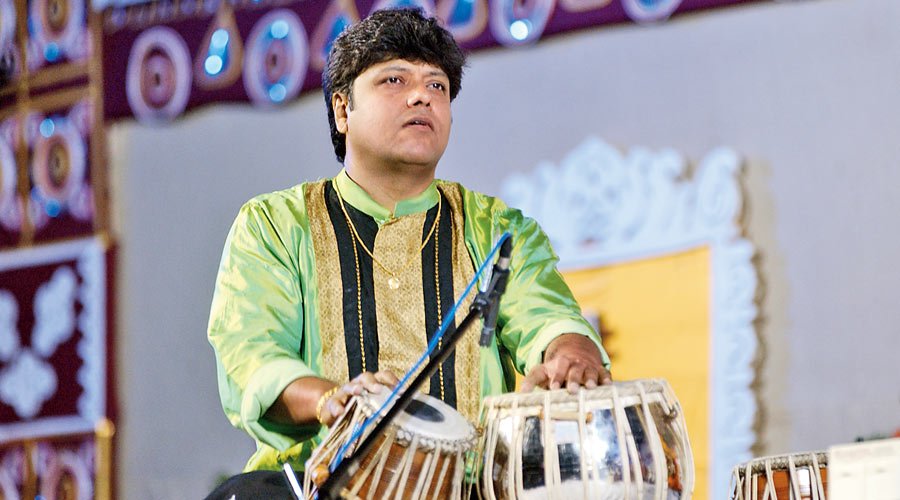
Subhankar Banerjee
Subhankar Banerjee of Calcutta, a representative of Farukhabad gharana, is an extremely talented tabla player. He received his initial training from his father, Sunil Kumar Banerjee. Later he continued his training under the guidance of Preetimoy Goswami and Swapan Siva. Subhankar has been on concert circuit since he was sixteen, and has performed with almost all distinguished vocalists and instrumentalists in the field of Indian classical music and has accompanied them on their concert tours of Europe, the U.S., Canada and several other countries.
Subhash Kamat
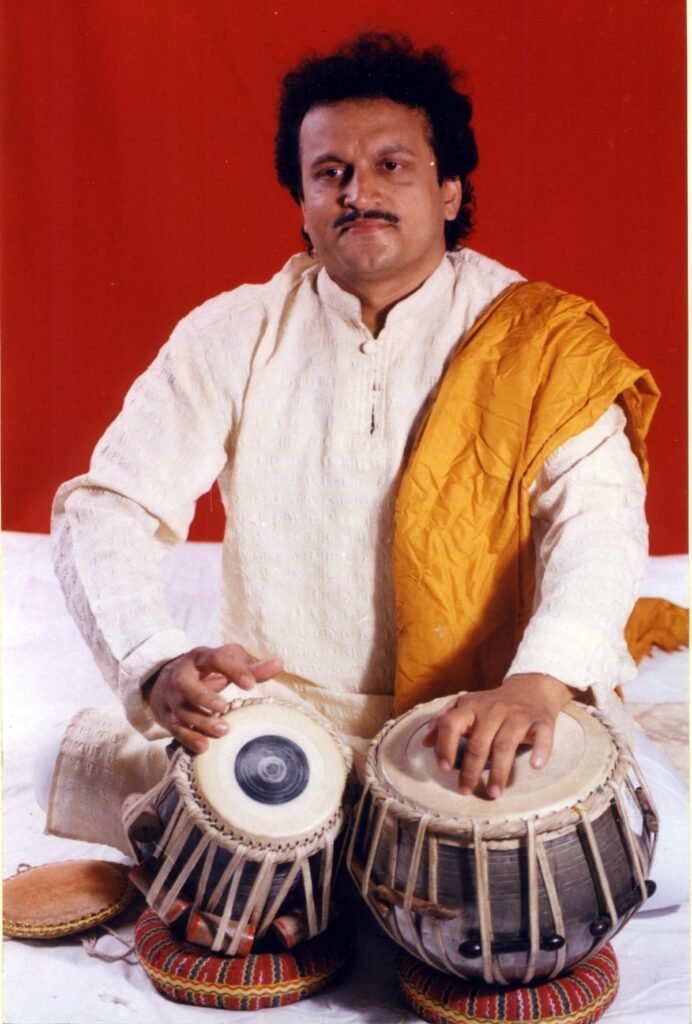
Subhash Kamat
Subhash Kamat has accompanied almost all the stalwarts of Hindustani classical music. He started learning Tabla from his father Pt. Chandrakant Kamt and later received further training from Pt. Samta Prasad, a doyen of Banaras Gharana. Subhash has participated in all the major music conferences in India and has traveled across USA, Canada and UK, for musical performances. He is a regular broadcaster on All India Radio (AIR) and Doordarshan.
Subhra Guha
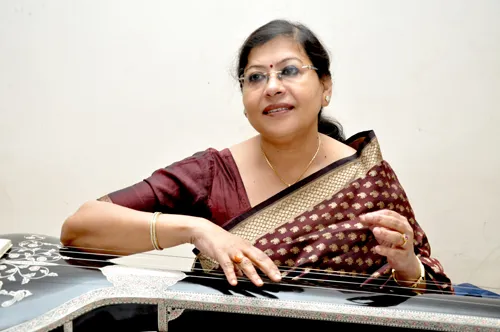
Subhra Guha
Subhra Guha is an exponent of the Agra Gharana and is one of the rising stars on the horizon on Indian Classical Music. She owes the magnificience of her voice to the superb training methods of her guru Pandit Sunil Bose, the veteran of the Agra Gharana, under whom she started her training in late 1970 in the traditional gurukul style at the Sangeet Research Academy. Subhra was trained earlier by Shri Satish Bhowmik. Subhra’s voice is striking, exhibiting magnificient training with exquisite tonal structure having continuity over range and a workability remarkably cut out for Khayal singing. Her singing displays all characteristics and values where vidya, impeccable ragdari and a rich gaikee comprise the edifice on which creativity rests. She has an incredible sense of layakari and her tone was full of strength, evenness and maturity and was particularly free from the touch of masculinity which is a typical drawback of most woman vocalists of the Agra Gayaki. Amongst the musicians of her generation, she has one of the largest and most exhaustive mental catalogues of ragas and compositions. Subhra is a regular broadcaster over All India Radio and Doordarshan. She has performed at the Sawai Gandharva Music Festival at Pune at the personal invitation of Pandit Bhimsen Joshi. Every singer dreams of such an opportunity. Some of her other noteworthy appearances include the Classic International Music Festival at Calcutta, SAPTASUR Music Festival at New Delhi, Gharana Sammelan at Bangalore, Raag Rangs Gayan Samaroh at Delhi and a host of other notable events.
Tanmoy Bose
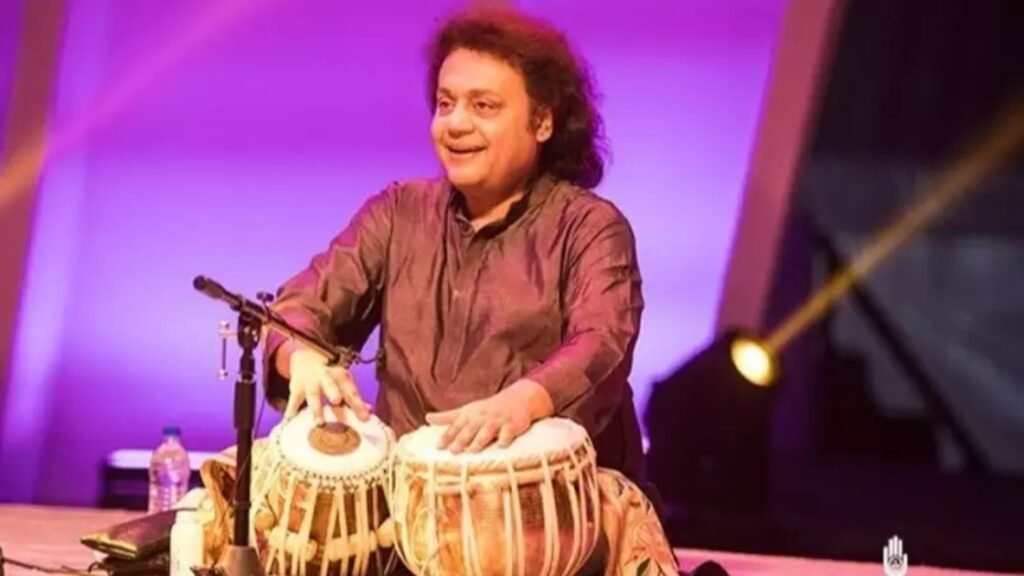
Tanmoy Bose
Tanmoy Bose, a distinguished tabla player of the present generation, was born into a family of music connoisseurs. The world of rhythm and percussion fascinated him from his very childhood , and he was driven by a keen desire to learn the tabla. Tanmoy has been privileged in receiving ‘talim’, or training , from the late Kanai Dutta and is now continuing his training from Pandit Shankar Ghosh in the ‘guru-shishya parampara’. Tanmoy combines technique, so successfully acquired from his guru, and his own imagination and dexterity, to bring forth music that is at once enthralling and exciting for his audience. His well-rounded, aesthetic approach to music is also partly due to his vocal training by Shree Maharaj Banerjee and his training on the harmonium by the late Pandit Mantu Banerjee.
Tejendra Narayan Majumdar

Tejendra Narayan Majumdar
Born in a musician’s family, Tejendra was initiated to sarod by his grandfather Sri Bibhuti Ranjan Majumdar, nurtured by his father Shri Ranjan Majumdar and groomed for years under the tutelage of Late Ustad Bahadur Khan. After his Ustad’s untimely demise, Tejendra continued his riyaz under the supervision of Sri Ajoy Sinha Roy. He bloomed under the guidance of the greatest sarod maestro of our times, Ustad Ali Akbar Khan. Tejendra’s music sparkles with the very rare combination of virtuosity with classical purity and a deep sense of aesthetics. His style today is a rare fusion of dhrupad, tantrakari and gayaki ang, representing the baaj of Maihar gharana. Tejendra took part in almost all the prestigious concerts and conferences in the country and abroad. He has to his credit a number of CDs and cassettes. Today he is one of the most popular classical musicians from India. He has established himself not only as a major artiste of the country but also as a connoisseur and critic’s delight. Tejendra has been accompanied by all great tabla players of India, including Pandit Kishan Maharaj, Sankar Ghosh, Pandit Swapan Chowdhary, Anindo Chatterjee, Kumar Bose, Sabir Khan and Ustad Zakir Hussain. .. Tejendra surpassed all other young players of the sarod… seems to peer above them all in his excellence alike in all departments of the sarod art. A great future certainly awaits him. Tejendra’s meends, with all their swimming grace, tempt one to call him ‘Meend ka Raja’. The Hindu .. Tejendra Majumdar’s sarod was aesthetically excellent. Technically, he has mastered the sarod to a level where he can move freely and with ease within the boundaries of his style. The Asian Age Most artistes tend to relax in their training and riyaz once they have collected a file of favorable press reviews and stagnate subsequently. But there are a few who never cease to be the disciple of music; they continue to learn and go on striving to attain greater heights in their art by keeping up their unrelenting practice. Tejendra belongs to the latter category. The Hindu …. The most impressive amongst the Maihar youngsters. The Telegraph …. Unpredictable note combination easily grips the audience. The Statesman … His raag-sense and aesthetic sense help him create passages which can truly be called excellent. The Economic Times
Ulhas Kashalkar
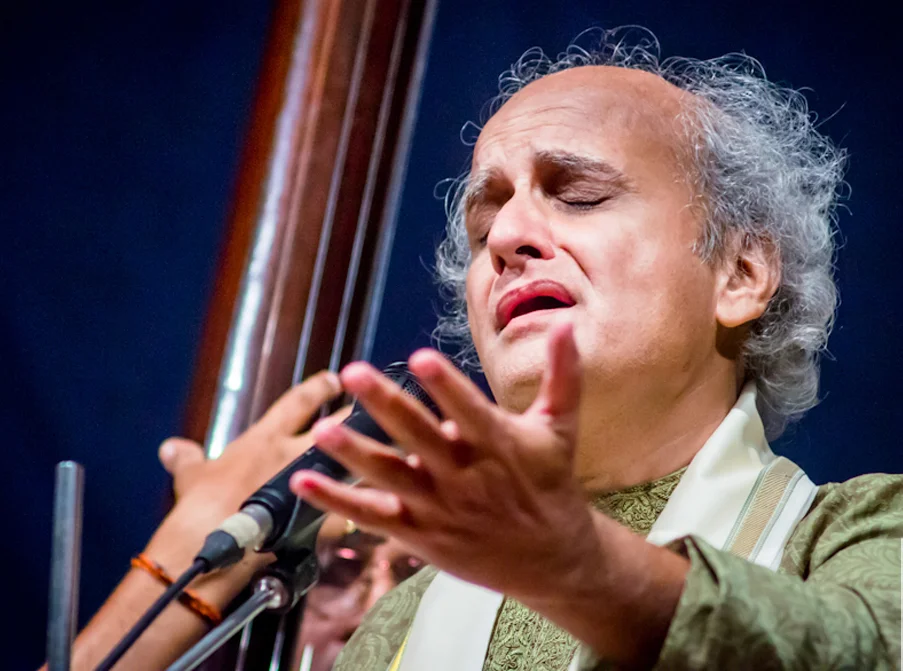
Ulhas kashalkar
Ulhas Kashalkar (b. 1955) hails from a family steeped in musical traditions. His father, Shri N.D. Kashalkar, provided him with not only the initial samskaras but the training as well. Ulhas showed signs of early promise by winning coveted prizes in competitions at a very young age. He pursued his studies in music at the Nagpur University and set his seal of excellence by annexing a Gold Medal at his M.A. examination. He was also the recepient of a Central Government scholarship for studies for a three year period. Ulhas then had the benefit of training under Pt. Ram Marathe, who in turn had assimiliated his gayaki from Pandit Mirashibua and Master Krishnarao of the Gwalior gharana, Pt. Jagannathbua Purohit (Gunidas) of the Agra gharana and Pt. Vamanrao Sadolikar of the Jaipur gharana. Ulhas has intervowen the silken threads of these three traditional gayakis to evolve a fascinating style of his own with the guidance from Pt. Gajananbua Joshi who is the living embodiment of the fusion of these gharanas. Today, Ulhas is a shining example of a harmonious blend of the finest there is in the Hindustani contemperary styles. His gayaki is a triumph of a melodious voice coupled with artistic perception. He is recognized as a “purist” by the stalwarts of the musical tradition, and is acclaimed to be one the finest vocalists in India by several eminent musicians such as Pt. V.G. Jog and artists of similar calibre and renown. Ulhas has been affiliated with the Pune station of the All India Radio for many years and has performed in several countries all over the world. Through his serious and dedicated approach to music, he has carved out a niche for himself in very discriminating circles of music. Ulhas is currently associated with the Sangeet Research Academy (SRA) in Calcutta, the premier foundation of North Indian Music where he teaches music to rising stars and contributes to the research environment actively. Ulhas has been to the DFW metroplex twice before and left the audience completely charmed by his music and his personality.
Ustad Ali Ahmed Hussain Khan

Ustad Ali Ahmed Hussain Khan
Ustad Ali Ahmed Hussain Khan of Allahabad, the acknowledged premier shehnai specialist of Eastern India was born in Calcutta on March 21, 1939. His grand-father late Ustad Wazir Ali Khan was the first to demonstrate Indian classical music on shehnai at Buckingham Palace. His father late Ustad Ali Jan Khan and gurus late uncle Ustad Nazir Hussain Khan and late Ustad Imdad Hussain Khan of Benares were also renowned shehnai specialists. He presents shehnai in a soft, subtle and sweet tone enriched with melodious and mellifluous patterns. The purity of raags in his performances is a hallmark of his steadfastness to tradition. He has taught shehnai at Sangeet Research Academy, Calcutta since 1974. Ustad Ali Ahmed is regularly featured on All India Radio and Indian Television. He holds the distinction of composing the signature tune for Indian Television with Pandit Ravi Shankar. He has played jugalbandhi both commercially and in live performances with artists such as Ustad Vilayat Hussain Khan on sitar, Pandit V. G. Jog on violin and late Ustad Munewar Ali Khan, vocals. His recordings are numerous and under variety of labels. Ustad Ali Ahmed has extensively traveled in India and abroad. His concert tours have included countries like United Kingdom, Germany, Switzerland, Holland, France, Belgium, Russia, Tunisia, Thailand, Singapore, Indonesia and Philippines, over a span of twenty years. On several occasions he has been invited/sponsored by governments and/or music festivals. He performed a duet with pianist Peter Michael Hamel at the Indo-German Festival. He participated in Music Festival Raag-Mala in the U.S. and Canada in 1994.
Ustad Rais Khan

Ustad Rais Khan
Ustad Rais Khan, born at Indore in 1939, belongs to one of the oldest and renowned musical families that still exists today. He is a direct descendant, through thirty generations, of the court musician to the Mughal Emperor in the 15th century. He is the torch bearer of a lineage which dates back to Ustad Haddu, Hassu and Natthu Khan Ustad Rais Khan’s forefathers settled in Indore and hence the stamp of “Mewat Gharana Baaj” to his style. His father, Ustad Mohammed Khan, started giving taalik to his son when he was only two and a half years old by presenting him a coconut shell Sitar. At the age of five, Khansahib gave his first public performance at the Sundarbhai Hall in the presence of the then Governor of Bombay Sir Maharaja Singh and his wife. Bye the age of nine he became an established artist of Hindustani Classical Music. In 1955, he was selected from a huge list of competitors from all over India to represent the Indian Nation at the International Youth Festival in Warsaw. At this event he won the Gold Medal in the string instruments category in which there were 111 competitors. This is the only gold medal received by an Indian in this category till today. Since then, Khansahib has been touring extensively throughout the world and delighting packed audiences at major capital cities. Khan sahib’s compelling presence and a unique and inimitable style of playing has captivated audiences all over the world. Khan sahib’s music has an intriguing if not hypnotic effect even on those listeners who are not aware of the complexities of the Sitar. The fact that Khansahib is an accomplished vocalist also adds to his popularity. At the end of his recitals, he often sings and demonstrates the same on the Sitar which thrills his listeners. They immediately see how vocal music closely relates to instrumental music. Had he taken up vocal music from the beginning he might have become a great vocalist too. Ustad Rais Khan has also been involved with the Indian Film music for about 30 years. Though many of his songs are very popular, most people do not know that those songs were created by him. Khansahib is married to the one of the most popular singers of Pakistan, Bilquees Khanum. He is the first Indian to have a recital televised on the PTV network in 1985.
Ustad Shahid Pervez

Ustad Shahid Pervez
Shahid Parvez hails from the famous lineage of the ‘Etawa Gharana’. He is the grandson of Ustad Wahid Khan, the Surbahar and Sitar virtuoso, and the younger brother of Ustad Inayat Khan. Recognized as a child prodigy, Shahid gave his first public performance at the age of eight. Since then he has had a meteoric rise and currently he is recognized internationally as one of the top performers of Sitar. While Shahid Parvez is famous for his outstanding ‘gayaki’ style exposition of the raaga in its introductory phase, the ‘alaap’, he has achieved a remarkable balance between the ‘gayaki’ (i.e. vocal) and the ‘tantrakari’ (i.e. instrumental) style of playing classical music. Shahid Parvez has performed at numerous festivals in India and has been on successful concert tours throughout the world.
Ustad Vilayat Khan

Ustad Vilayat Khan
Ustad Vilayat Khan is regarded by many as being one of the greatest North Indian musicians of this century. Coupled with this reputation is his indomitable and incorruptible character which renders him, in the eyes of many of his followers, as a legend in his own time. Khanshahib was born into a family of musicians who trace their lineage six or seven generations back to the Moghul courts and ultimately to Miyan Tansen, the court musician of the Emperor Akbar (late 16th century). His grandfather, Imdad Khan, and his father, Enyet Khan, were recognized as leading instrumentalists of their time. The date of Vilayat Khan’s birth is the first point of controversy, some saying 1924, others 1926 or 1927. He says 1928. He studied music under his father’s guidance from a very early age and needless to say he was precocious. After his father’s death in 1938, he continued his training under his mother, Bashiran Begum, his maternal grandfather, Bande Hussain Khan and maternal uncle, Zinda Hussain Khan, all accomplished vocalists. Khanshahib shot to fame in 1944 when he was invited to perform at a music festival in Bombay. The audience applause was such that he was obliged to play five encores, and so the legend begins. One hears of the time he performed later in Bombay when all seats were sold well in advance and the organizers placed loudspeakers outside the theater and the streets were crowded with ten thousand standing in rapt attention. Khanshahib has by now achieved the highest acclaim all over the world and has performed in the most prestigious theaters and has the unique distinction of having performed in Buckingham Palace for Queen Elizabeth II. It is also a fact, however, that when he was finally awarded the Padma Shri and Padma Vibhushan awards in 1964 and 1968 – the highest recognition given by the Government of India – he refused them on the grounds that the committee was incompetent to judge artistic creativity. It is his extraordinary musical creativity that has made Vilayat into a legend. We now tend to take for granted so much of his inventiveness, and yet he continues to come up with something new. Listening to recordings from the pre-World War II period is the only way to experience just how much Vilayat has changed the nature of sitar music to its present “singing” (gayaki) vocal style. The new tunings of the drone strings he has introduced (in spite of reducing the number of melody/drone strings from seven to six) and the sustaining power of modern sitars, enable sitarists to sound as many as ten or more notes through side-ways deflections of the playing strings. One only needs to hear Khanshahib illustrate these features by singing phrases and then replicating them on the sitar – as he has often done even in formal concerts – to understand something of his immense contributions to North Indian classical music.
Vikay Kumar Kichlu

Vikay Kumar Kichlu
Vijay Kichlu, a master of arts from the University of Allahbad, is a unique combination of executive ability and artistry. After an impressive career as a mercantile executive, Vijay Kichlu is now at the helm of the revolutionary institution in the field of arts, Sangeet Research Academy, a creation of the well-known commercial house, ITC Limited. As the executive director of SRA, Vijay Kichlu is totally committed to classical music, its propagation and preservation. Although he did not take music as a profession, Vijay Kichlu has been recognized as a leading vocalist of the Agra gharana in the country with an impressive standard of musicianship. His initial training in the music commenced at the tender age of seven with Pandit Nathuram Sharma. Later, he was greatly influenced by the gayaki of Ustad Faiyaz Khan, the colossus of the Agra gharana. While in college at Varanasi he had the good fortune of becoming the disciple of Ustad Moinuddin Dagar and the Ustad Aminuddin Dagar, popularly known as Dagar Brothers and the torchbearers of the dhrupad style. Then he took guidance from the late Ustad Latafat Hussain Khan of the Agra gharana. He follows the Agra gayaki, his forte being alapchari in the traditional dhrupad style composition in madhya laya and the bol-taans true to the character of the gharana gayaki. Vijay Kichlu is an A grade artiste of all India Radio and Doorsdarshan TV. He, along with his younger brother Ravi Kumar Kichlu, appeared several times in the Sangeet Program of Music of All India Radio, Radio Sangeet Sammelan and Doorsdarshan. This apart, he regularly broadcasts vocal music through All India Radio and Doorsdarshan, Calcutta. He has an impressive record of public performances of classical vocal music all over India and in the USA, Canada, Europe and the Middle East countries. He participated in the Festival Of India held in the USA. An erudite musician and a very fluent speaker, Vijay Kichlu has rapidly risen to fame in musicological circle. His lecture-demonstrations and compact workshops are pleasantly enlightening for the listener and participant. He has made significant contributions in several important musicals and musicological meets all over the world, significantly in Italy, Philippines, the USA and West Germany. He has been granted Honorary Citizenship of the State of Maryland and also of the City of Baltimore by the Governor of Maryland and the Mayor of Baltimore respectively in appreciation of his services for the promotion of Indian Classical music in the USA.
Viji Krishnan-Natarajan
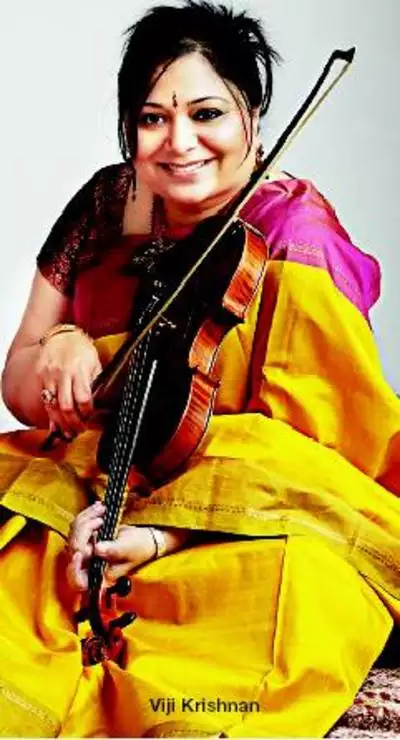
Viji Krishnan-Natarajan
Viji Krishnan-Natarajan represents the seventh generation in a family of distinguished musicians who have contributed enormously to Indian music. Her initial training began at the age of three, under the tutelage of their grandfather A. Narayana Iyer and later from her illustrious father, the world renowned Violin maestro Professor T. N. Krishnan. Viji a child prodigy, gave her first performance at the age of seven when The Hindu reported her to be, “a chip off the old block”. Ever since, she has been touring and performing all over the world, including the U.S., Canada, Singapore, Malaysia, Sri Lanka and Europe. Her concerts at major music festivals moved the New York Times to comment that she was, “a Paganini of the East”. Viji has also performed for various radio and television stations in the U.S. and abroad. She has recorded for major recording companies. Her style combines Western bowing and fingering techniques which lends to her music, a rich tonal quality. Her deep knowledge of Carnatic music has allowed her to, in what the L A. Times described as, “improvise and create moments of great poignancy and beauty”. Besides being an outstanding performer, who The Statesman hailed as, “a maestro in the making,” Viji Krishnan-Natarajan also has a strong theoretical and academic background in music. Her passion to understand other music systems led her to doctoral program at the University of Illinois at Urbana-Champaign. This, combined with her early proficiency on the piano, has left her better equipped to express her music to Western audiences.
Viraj Amar
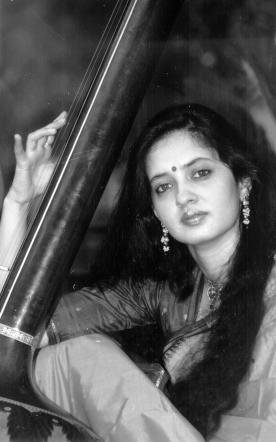
Viraj Amar
Viraj Amar is a young upcoming vocalist of Hindustani classical music. Her gurus include Pandit Vilasrao Khandekar of Gwalior gharana, Smt. Rupande Shah of Saptak School of Music and presently Pandit Rajan Misra of Benares gharana. She started her music career with sitar at the age of 8 under the able guidance of Ms. Manjuben Mehta and her vocal training under Pandit Vilasrao Khandekar at age 10. Since then she has won the coveted Pandit Omkarnath Trophy in both instrumental as well as vocal music and the All India Intercollegiate competition for Hindustani vocals. She is a Sangeet Visharad, a Sangeet Alankar and an A-grade artist on All India Radio where she regularly performs. Her academic achievements consist of a Bachelor of Science in Bio-Chemistry and a Master of Science in Life Science. Viraj has performed widely in India including performances at the National Center of Performing Arts, Bombay, the Saptak Music Festival, Ahmedabad, Swara Sadhana Samiti, Bombay and Bharat Bhavan, Bhopal. Viraj was invited to perform vocals at the Indo-Soviet Festival, Russia, in 1988. She was also invited to Otemon Gaukuin University, Japan, as a cultural ambassador in 1990. For concert performances contact: Ms. Viraj Amar 47, Brahmin Mitra Mandal Society Ahmedabad 380 006, India (91) (79) 657 7594 (Home) (91) (79) 657 9210 (Facsimile)
